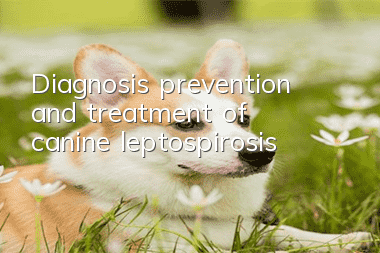Diagnosis, prevention and treatment of canine leptospirosis

Canine leptospirosis is a zoonotic disease caused by pathogenic Leptospira. Dogs mainly show symptoms such as hemorrhagic jaundice, high fever, hemorrhagic diathesis, abortion, skin necrosis, edema and other symptoms. The disease mostly occurs in tropical and subtropical areas. With the cross-regional trading of dogs, it also occurs in northern my country.
English Springer Spaniel
Canine Leptospirosis Symptoms
Dogs of all ages can be infected. The incidence rate is higher in male dogs than in female dogs. The incubation period is 5-15 days.
Acute cases can occur suddenly, with body weakness, inability to eat, vomiting, elevated body temperature (39.5-40°C), depression, hindquarter muscle stiffness and pain, reluctance to stand up and walk, difficulty breathing, and varying degrees of jaundice on the visible mucous membranes. or bleeding. Generally, the body fails and the body temperature drops and death occurs within 2 days.
Subacute symptoms are characterized by fever, vomiting, anorexia, dehydration, jaundice, and mucosal necrosis. Irregular bleeding spots and jaundice can be seen on the oral mucosa of sick dogs; symptoms of conjunctivitis can be seen in the eyes. Mucous discharge can be seen in the corners of the eyes. Coughing, wheezing and difficulty breathing can also be seen. Some dogs with the disease show symptoms such as polydipsia and polyuria. Dogs with subacute infection recover after about 2-3 weeks.
Chronic symptoms often come back as acute or subacute symptoms. It often appears as chronic liver, kidney and gastrointestinal symptoms, and most of them can be recovered through symptomatic treatment. A few died of uremia, cirrhosis, ascites, and body failure.
Diagnosis of canine leptospirosis
Based on clinical autopsy findings, Leptospira can be detected in urine microscopy and serological tests are used for diagnosis.
Treatment of canine leptospirosis
(1) Penicillin and streptomycin have good curative effect on this disease. Penicillin 40,000-80,000 units/kg body weight, streptomycin 10-15 mg/kg body weight mixed intramuscular injection twice a day.
(2) Symptomatic treatment. Replenish fluids, sugar, and alkali. Therapies include eliminating gastrointestinal symptoms, stopping bleeding, and eliminating skin and mucous membrane ulcers. Generally, 200-500 ml of 5% glucose saline and 10-40 ml of 5% sodium bicarbonate injection can be mixed for intravenous infusion. To prevent vomiting, intramuscular injection of metoclopramide 2 mg/kg body weight can be used; or oral domperidone tablets 2 mg/kg body weight can be used twice a day. To stop bleeding, use Vk 12 mg/kg body weight or VK 31 mg/kg body weight for intramuscular injection 2 times a day. Oral mucosal ulcers can be coated with iodine glycerin.
Canine Leptospirosis Prevention
The currently commonly used Leptospira polyvalent vaccine has the same immunization procedures and methods as the canine distemper vaccine.
In addition, rodent control work must be done well. Rats are the reservoir host of this disease. To prevent sick dogs from coming into contact with other dogs, the environment must be disinfected and kept in isolation.
- What to do if your dog vomits after eating chili peppers
- When should German Shepherd puppies be vaccinated?
- What should I do if my dog is not energetic and won’t eat?
- Dog snorts in the nose
- Wipe dog tear stains with light salt water
- Will it be okay if a dog eats shrimp shells?
- Will a dog die immediately if he eats ibuprofen?
- How many days can a dog usually live with internal bleeding?
- What can gray teddy eat to make their coat color more beautiful?
- Signs 5 hours before Teddy gives birth



